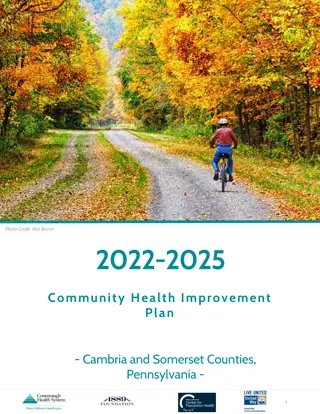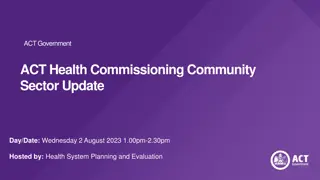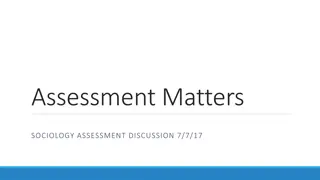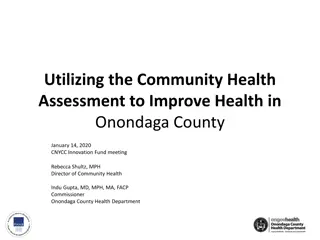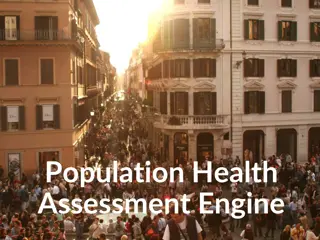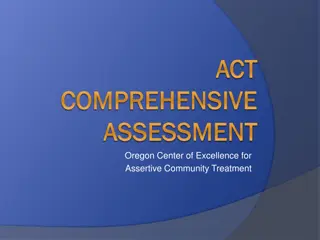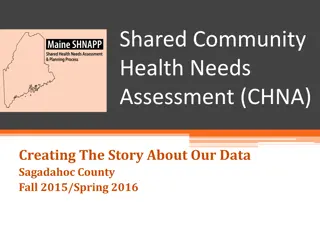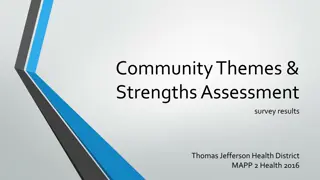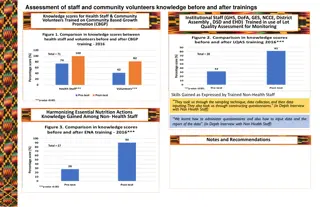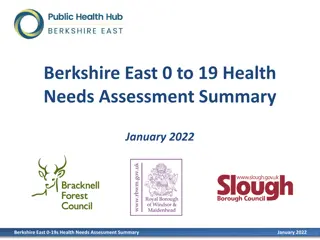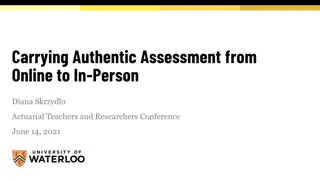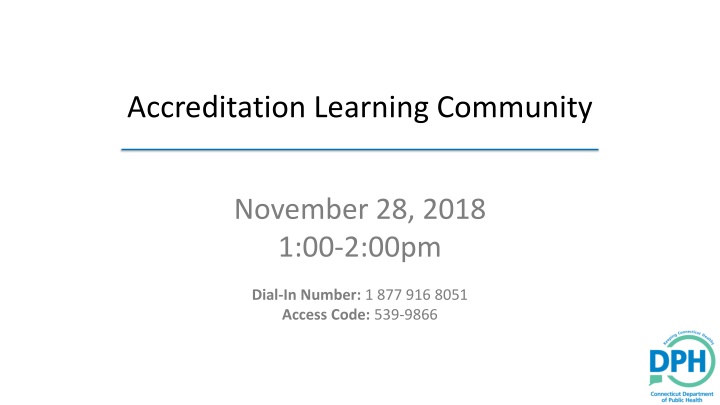
Comprehensive Community Health Assessment Strategies
Engage stakeholders for a collaborative community health assessment process, prioritize indicators, and advance health equity through data-driven initiatives focusing on social determinants and community resilience.
Download Presentation

Please find below an Image/Link to download the presentation.
The content on the website is provided AS IS for your information and personal use only. It may not be sold, licensed, or shared on other websites without obtaining consent from the author. If you encounter any issues during the download, it is possible that the publisher has removed the file from their server.
You are allowed to download the files provided on this website for personal or commercial use, subject to the condition that they are used lawfully. All files are the property of their respective owners.
The content on the website is provided AS IS for your information and personal use only. It may not be sold, licensed, or shared on other websites without obtaining consent from the author.
E N D
Presentation Transcript
Accreditation Learning Community November 28, 2018 1:00-2:00pm Dial-In Number: 1 877 916 8051 Access Code: 539-9866
SHA 2.0 Indicator Prioritization Criteria SHA 2.0 Indicators All indicators must be: Reliable or validated (studies in the larger literature show strong consistency and validity) Available over time (5 years ago or newer) Available by population sub-group and/or geography (e.g., county level) Other Criteria include: Magnitude (size) Seriousness Ability to change (feasibility) Health Equity Root cause or social determinant that affects multiple health issues Quality of data Trend data available Comparison data available
Participate in or Lead a Collaborative Process Resulting in a Comprehensive Community Health Assessment (Standard 1.1 Measure 1.1.1, Measure 1.1.2)
Advancing Health Equity through the Community Health Assessment Create a table for CHA and CHIP engagement that centers on community voice partner with individuals or organizations that represent populations most impacted by health inequities Include data and data analysis from other government agencies, such as housing, transportation, police, parks and rec, etc. Actively engage community members most impacted by health inequities in: Selecting focus areas and project-specific and department-wide indicators, data, and priority measures Data analysis - as they have key insights, history, stories, and information about why we see inequities. Highlight data and stories on community resiliency and community-led efforts to achieve health equity
Measure 1.1.1 T/L: Partnership that develops a comprehensive community health assessment Required Documentation 1 The partners you engage should represent the community and stakeholders you serve Stakeholders are any person or organization affected by a decision or policy or who may have information that affects the decision or policy Participation from diverse stakeholders enrich the CHA and bring depth to the document beyond the data collected.
DPHs Approach Sector and Stakeholder Wheel Sector and Stakeholder Wheel is a different way to look at the public health system Ensures inclusion of a diverse group of stakeholders for participation in the SHA Other connections may not be as intuitive, but engagement of those stakeholders is really essential for addressing social, economic, and environmental determinants of health.
Measure 1.1.1 T/L: Partnership that develops a comprehensive community health assessment Required Documentation 2 Must document that partnership meets and communicates on a regular basis Documentation should be supportive enough to demonstrate what was accomplished at the meeting or during the communications
Measure 1.1.1 T/L: Partnership that develops a comprehensive community health assessment Required Documentation 3 Must document the process used to identify and collect data/information There is no prescribed model agencies must use, but whichever process an agency chooses should engage partners throughout the process and address social determinants of health
Measure 1.1.2 T/L: A tribal/local community health assessment Required Documentation 1a Must document the identification and description of the community s health and areas for health improvement, the factors that contribute to the health challenges, and the existing community resources that can be mobilized to address them.
Measure 1.1.2 T/L: A tribal/local community health assessment
Measure 1.1.2 T/L: A tribal/local community health assessment Required Documentation 1b Provides the health department with knowledge of who their community is and where socioeconomic inequities may exist
Measure 1.1.2 T/L: A tribal/local community health assessment Required Documentation 1c and 1d
Measure 1.1.2 T/L: A tribal/local community health assessment Required Documentation 1e Intent is to identify and map resources that can be leveraged to improve health Community Asset: A quality, person, or thing that is an advantage, a resource, or an item of value to an organization of community. Public Health Assets can include individuals, organizations, institutions, and environmental assets
Measure 1.1.2 T/L: A tribal/local community health assessment Required Documentation 2 Benefits of engaging the community in the development of the assessment increases awareness of the assessment, communicates the value of public health, and provides stakeholders the opportunity to contribute to the report The health department could collect primary data and qualitative data during events that seek community input
Engaging Stakeholders in the CHA Methods of engagement: Survey (via mail, phone, web, or in person) Recruit community partners who work with priority populations to post the survey on their websites or provide them at their locations (i.e. associations, physician offices) Community Forums/Listening Sessions Could be considered town hall meetings or other public event Focus Groups Key Informant Interviews
State Health Assessment SHA 1.0 Public Forums on the 2014 SHA Draft Hosted one in each CT county Spanish Webinar Special forum for other state agencies SHA 2.0 Plan of Action Online Survey (February 2019) Coalition Summit (Spring/Summer 2019) Public Input Survey (Summer 2019) Community Forums in each county (Fall 2019)
Discussion Questions How have you identified partners and stakeholders to bring to the table in the development of the SHA? How have you sought public input to supplement your CHA and/or to receive feedback on preliminary findings? What have you found to be the most effective way to engage the community in the development/sharing of your CHA?
Next Meeting January 2019 December ALC will be canceled due to scheduling conflicts and holidays An evaluation on the ALC will become available in the next few weeks. Please take 5 minutes to complete it and be honest! The goal of the ALC is to be as helpful as possible to you and your team on your accreditation journey. Next meeting will be January 23, 2019. A new calendar series will be sent out for 2019.

